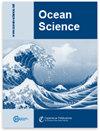Global water level variability observed after the Hunga Tonga-Hunga Ha'apai volcanic tsunami of 2022
IF 3.3
3区 地球科学
Q2 METEOROLOGY & ATMOSPHERIC SCIENCES
引用次数: 0
Abstract
Abstract. The eruption of the Hunga Tonga-Hunga Ha'apai volcano on 15 January 2022 provided a rare opportunity to understand global tsunami impacts of explosive volcanism and to evaluate future hazards, including dangers from “volcanic meteotsunamis” (VMTs) induced by the atmospheric shock waves that followed the eruption. The propagation of the volcanic and marine tsunamis was analyzed using globally distributed 1 min measurements of air pressure and water level (WL) (from both tide gauges and deep-water buoys). The marine tsunami propagated primarily throughout the Pacific, reaching nearly 2 m at some locations, though most Pacific locations recorded maximums lower than 1 m. However, the VMT resulting from the atmospheric shock wave arrived before the marine tsunami and propagated globally, producing water level perturbations in the Indian Ocean, the Mediterranean, and the Caribbean. The resulting water level response of many Pacific Rim gauges was amplified, likely related to wave interaction with bathymetry. The meteotsunami repeatedly boosted tsunami wave energy as it circled the planet several times. In some locations, the VMT was amplified by as much as 35-fold relative to the inverse barometer due to near-Proudman resonance and topographic effects. Thus, a meteotsunami from a larger eruption (such as the Krakatoa eruption of 1883) could yield atmospheric pressure changes of 10 to 30 mb, yielding a 3–10 m near-field tsunami that would occur in advance of (usually) larger marine tsunami waves, posing additional hazards to local populations. Present tsunami warning systems do not consider this threat.2022年Hunga Tonga-Hunga Ha'apai火山海啸后的全球水位变化
摘要2022年1月15日,Hunga Tonga-Hunga Ha'apai火山爆发,为了解爆炸性火山活动对全球海啸的影响和评估未来的危害提供了难得的机会,包括火山爆发后大气冲击波引发的“火山气象海啸”(VMTs)的危险。利用全球分布的1分钟气压和水位(来自潮汐计和深水浮标)测量数据,分析了火山和海洋海啸的传播。海洋海啸主要在整个太平洋传播,在一些地方达到近2米,尽管大多数太平洋地区的最高记录低于1米。然而,大气冲击波产生的VMT在海洋海啸之前到达,并在全球传播,在印度洋、地中海和加勒比地区产生了水位扰动。由此产生的许多环太平洋水位计的水位响应被放大,可能与波浪与测深法的相互作用有关。海啸在绕地球几圈的过程中不断提高海啸波的能量。在某些地方,由于近普鲁德曼共振和地形效应,相对于逆气压计,VMT被放大了35倍。因此,一次较大的火山喷发(如1883年的喀拉喀托火山喷发)产生的海啸可能会产生10到30毫巴的大气压力变化,产生3到10米的近场海啸,这种海啸会在(通常)更大的海洋海啸波之前发生,对当地居民造成额外的危害。目前的海啸预警系统没有考虑到这种威胁。
本文章由计算机程序翻译,如有差异,请以英文原文为准。
求助全文
约1分钟内获得全文
求助全文
来源期刊

Ocean Science
地学-海洋学
CiteScore
5.90
自引率
6.20%
发文量
78
审稿时长
6-12 weeks
期刊介绍:
Ocean Science (OS) is a not-for-profit international open-access scientific journal dedicated to the publication and discussion of research articles, short communications, and review papers on all aspects of ocean science: experimental, theoretical, and laboratory. The primary objective is to publish a very high-quality scientific journal with free Internet-based access for researchers and other interested people throughout the world.
Electronic submission of articles is used to keep publication costs to a minimum. The costs will be covered by a moderate per-page charge paid by the authors. The peer-review process also makes use of the Internet. It includes an 8-week online discussion period with the original submitted manuscript and all comments. If accepted, the final revised paper will be published online.
Ocean Science covers the following fields: ocean physics (i.e. ocean structure, circulation, tides, and internal waves); ocean chemistry; biological oceanography; air–sea interactions; ocean models – physical, chemical, biological, and biochemical; coastal and shelf edge processes; paleooceanography.
 求助内容:
求助内容: 应助结果提醒方式:
应助结果提醒方式:


